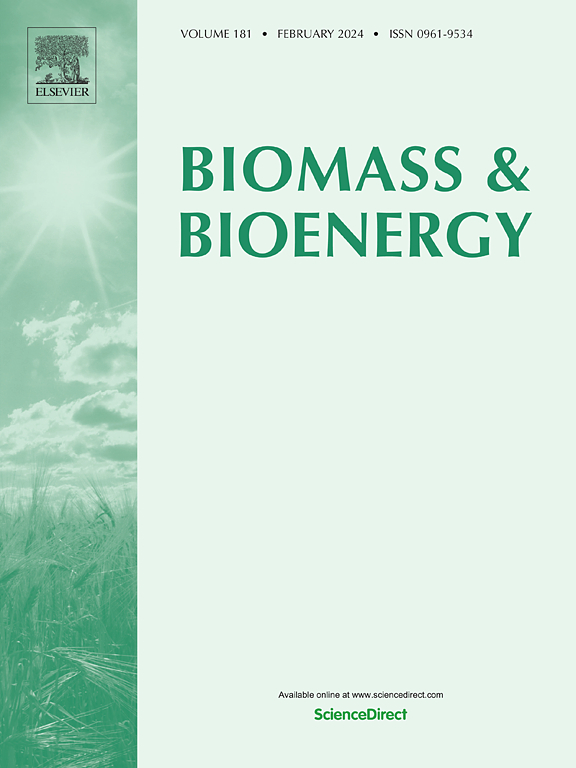Study on preparation of new solid fuel and its combustion performance from bio-oil and waste cooking oil mixture via vacuum distillation
IF 5.8
2区 生物学
Q1 AGRICULTURAL ENGINEERING
引用次数: 0
Abstract
The mixture of bio-oil and waste cooking oil with long carbon-chain was used to produce bio-coal via vacuum distillation, so as to improve its physicochemical properties especially its combustion performance as a new solid fuel. The effect of ratio of meat or vegetable oil represented by lard and soybean oil in the mixture (L-Oil and S-Oil) on the physical and chemical properties of bio-coal was studied emphatically. The results revealed that the bio-coal obtained via vacuum distillation of bio-oil mixed with 40 % S-oil (SBC) including more carbon content and fatty acid presented better physicochemical properties than that of bio-coal obtained by mixing L-oil (LBC) with higher carbon content (82.74 %) and calorific value (34.19 MJ/kg) basically similar to that of the commercial coal. The above bio-coal and anthracite were mixed to investigate their combustion characteristics. The TG analysis revealed that there is a synergistic effect in the combustion of the mixed bio-coal and anthracite, and the combustion temperature range of bio-coal are lower than that of anthracite. Further mixing of bio-coal was helpful to improve the flame stability and reduce the ignition temperature. Kissen-Akahira-Sunose (KAS), Flynn-WallOzawa (FWO) and Starink were used for the kinetic analysis, and the statistical R2 factors of the three methods were greater than 0.973, which reflected the high reliability of the calculation methods, and proved that the kinetics of the process are significantly influenced by the calorific rate. Overall, the high-valued utilization of bio-oil and food waste was realized in this study to produce a sustainable fuel.
生物油与废食用油混合料真空蒸馏法制备新型固体燃料及其燃烧性能研究
将生物油与长碳链废食用油混合,采用真空蒸馏法制备生物煤,以改善生物煤的理化性质,特别是燃烧性能,使其成为一种新型固体燃料。重点研究了混合油(L-Oil和S-Oil)中以猪油和大豆油为代表的肉油或植物油的比例对生物煤理化性能的影响。结果表明,将含碳量和脂肪酸含量较高的40% s油(SBC)与生物油(LBC)混合真空蒸馏得到的生物煤具有更好的物理化学性质,其含碳量为82.74%,热值为34.19 MJ/kg,与商品煤基本相似。将上述生物煤与无烟煤混合,研究其燃烧特性。热重分析表明,生物煤与无烟煤混合燃烧存在协同作用,燃烧温度范围低于无烟煤。进一步掺加生物煤有利于提高燃烧稳定性,降低着火温度。采用Kissen-Akahira-Sunose (KAS)、Flynn-WallOzawa (FWO)和Starink三种方法进行动力学分析,三种方法的统计R2因子均大于0.973,反映了计算方法的高可靠性,证明了该过程的动力学受发热量的显著影响。总的来说,本研究实现了生物油和食物垃圾的高价值利用,生产出一种可持续的燃料。
本文章由计算机程序翻译,如有差异,请以英文原文为准。
求助全文
约1分钟内获得全文
求助全文
来源期刊

Biomass & Bioenergy
工程技术-能源与燃料
CiteScore
11.50
自引率
3.30%
发文量
258
审稿时长
60 days
期刊介绍:
Biomass & Bioenergy is an international journal publishing original research papers and short communications, review articles and case studies on biological resources, chemical and biological processes, and biomass products for new renewable sources of energy and materials.
The scope of the journal extends to the environmental, management and economic aspects of biomass and bioenergy.
Key areas covered by the journal:
• Biomass: sources, energy crop production processes, genetic improvements, composition. Please note that research on these biomass subjects must be linked directly to bioenergy generation.
• Biological Residues: residues/rests from agricultural production, forestry and plantations (palm, sugar etc), processing industries, and municipal sources (MSW). Papers on the use of biomass residues through innovative processes/technological novelty and/or consideration of feedstock/system sustainability (or unsustainability) are welcomed. However waste treatment processes and pollution control or mitigation which are only tangentially related to bioenergy are not in the scope of the journal, as they are more suited to publications in the environmental arena. Papers that describe conventional waste streams (ie well described in existing literature) that do not empirically address ''new'' added value from the process are not suitable for submission to the journal.
• Bioenergy Processes: fermentations, thermochemical conversions, liquid and gaseous fuels, and petrochemical substitutes
• Bioenergy Utilization: direct combustion, gasification, electricity production, chemical processes, and by-product remediation
• Biomass and the Environment: carbon cycle, the net energy efficiency of bioenergy systems, assessment of sustainability, and biodiversity issues.
 求助内容:
求助内容: 应助结果提醒方式:
应助结果提醒方式:


